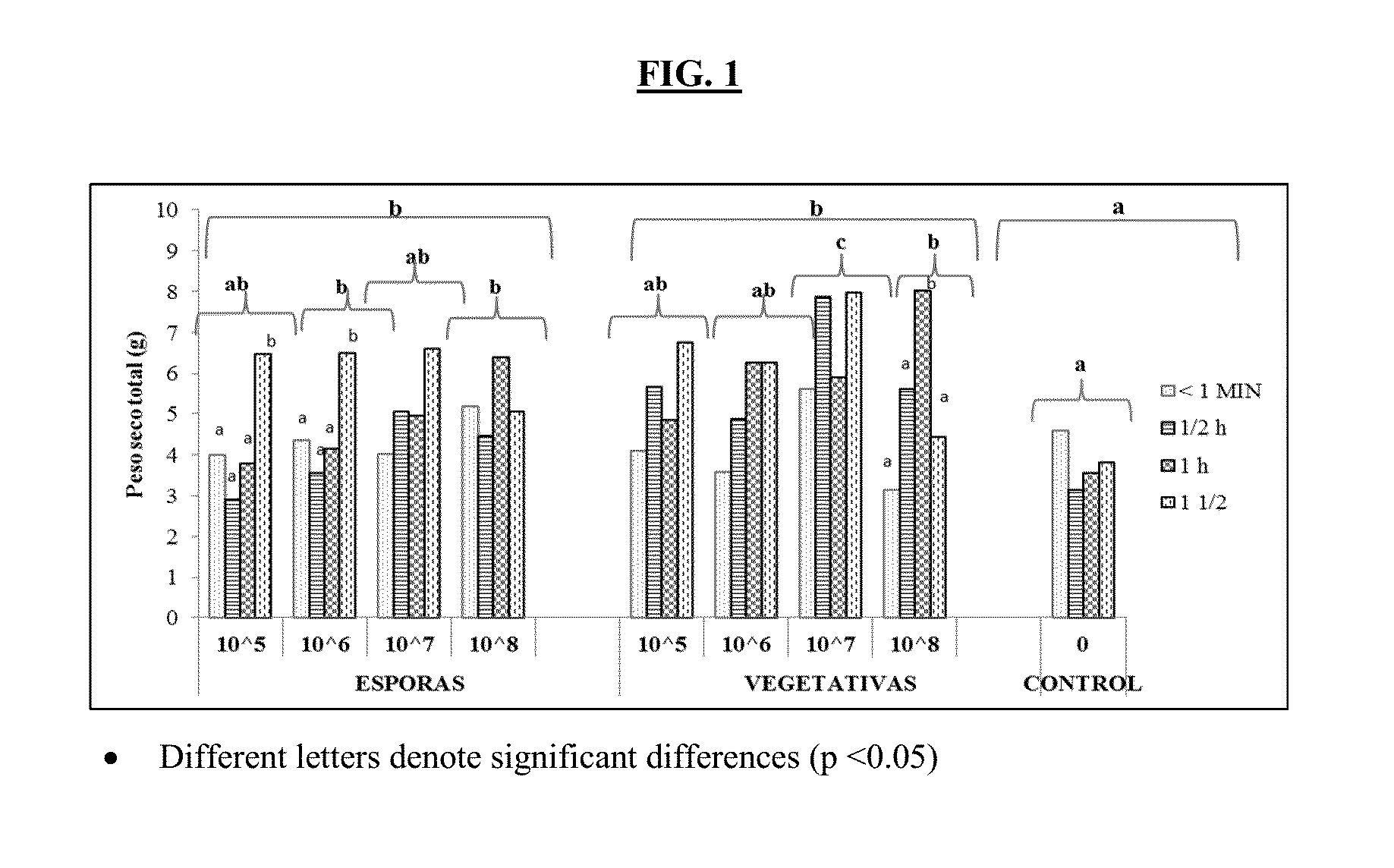Process for increasing biomass and spores production of plant growth promoting bacteria of the bacillus genus
a technology of bacillus genus and biomass, which is applied in the field of process for increasing the production of biomass and spores of plant growth promoting bacteria of the bacillus genus, can solve the problems of poor sporulation efficiency
- Summary
- Abstract
- Description
- Claims
- Application Information
AI Technical Summary
Benefits of technology
Problems solved by technology
Method used
Image
Examples
example 1
Obtaining and Identifying Strains of Plant Growth Promoting Microorganisms of the Bacillus Genus
[0021]Strains of Bacillus sp. were isolated from the rhizosphere of plantain plants (Musa AAA) originating from Urabá (Antioquia), Colombia. Rhizosphere soil and plant roots from production fields were used for this isolation process. A suspension of the samples was prepared in a phosphate buffer and subsequent serial dilutions were plated on TSA (trypticase soy agar) culture medium.
[0022]To select the Bacillus microorganisms, the samples were subjected to thermal shock at 80° C. for 20 minutes and resistant organisms were purified and stored in TSB medium with 20% glycerol at −80° C. (24). Table 1 shows the strains of PGPR microorganisms and their isolation source. The microorganisms were identified using 16s rDNA gene sequencing (24).
TABLE 1PGPR bacteria, Isolation and IdentificationPLACE OFORIGINATINGSPECIESCODEISOLATIONPLANTBacillusEA-CB0123Urabá,Musa AAA GrandamyloliquefaciensColombi...
example 2
Designing and Optimizing the Culture Medium
[0023]After a review of relevant literature (20, 21, 25-30), the most important sources of nutrients and macronutrients for the growth of microorganisms of the Bacillus genus were selected, and Placket and Burman (PBD) experiments were designed in order to identify the factors that have significant effects.
[0024]Assessed factors include the sources of carbon (C6H12O6), magnesium (MgSO4*7H2O), manganese (MnCl2*4H2O), phosphorus-potassium (KH2PO4), and nitrogen (yeast extract, meat extract, peptone, and (NH4)2SO4), while on the other hand, variables include viable biomass concentration (CFU / mL), spores, and sporulation rate, defined as the ratio of spores to biomass. An analysis of variance (ANOVA) with a significance level of 5% was carried out. Table 2 shows concentration ranges for each analyzed factor.
TABLE 2Plackett and Burman design for the culture medium of the inventionFACTORS (g / L)YeastMeatTreatmentC6H12O6MgSO4*7H2OMnCl2*4H2OKH2PO4ex...
example 3
Production of Biomass and Spores from Bacillus Genus in a Bioreactor
[0027]The preinoculum was prepared by transferring three colonies of a solid culture of B. subtilis to 250 mL of SBM culture media. Stirring at 150 rpm was carried out for 24 hours at 30° C. The DO600 of the preinoculum was adjusted to 2.0 with SBM sterile medium. The preinoculum was added at a ratio of 1 to 10% v / v.
[0028]An inoculum containing between 1×105 and 1×109 CFU / mL of the Bacillus sp. microorganism was added to 7 liters of SMB culture medium held in a BioFlo® 110 bioreactor (New Brunswick Scientific Co.) with a ring diffuser, two turbine impellers, and devices for measuring temperature, pH, and dissolved oxygen.
[0029]To ensure the required physicochemical conditions, pH was adjusted to 5.5 and temperature was maintained at 30° C. for 60 hours, with 1.5 vvm aeration, and stirring at 430 rpm. Biomass production was between 1.0×108 CFU / mL and 1.0×1010 CFU / mL, with sporulation percentages greater than 92%. Tab...
PUM
 Login to View More
Login to View More Abstract
Description
Claims
Application Information
 Login to View More
Login to View More - R&D
- Intellectual Property
- Life Sciences
- Materials
- Tech Scout
- Unparalleled Data Quality
- Higher Quality Content
- 60% Fewer Hallucinations
Browse by: Latest US Patents, China's latest patents, Technical Efficacy Thesaurus, Application Domain, Technology Topic, Popular Technical Reports.
© 2025 PatSnap. All rights reserved.Legal|Privacy policy|Modern Slavery Act Transparency Statement|Sitemap|About US| Contact US: help@patsnap.com


